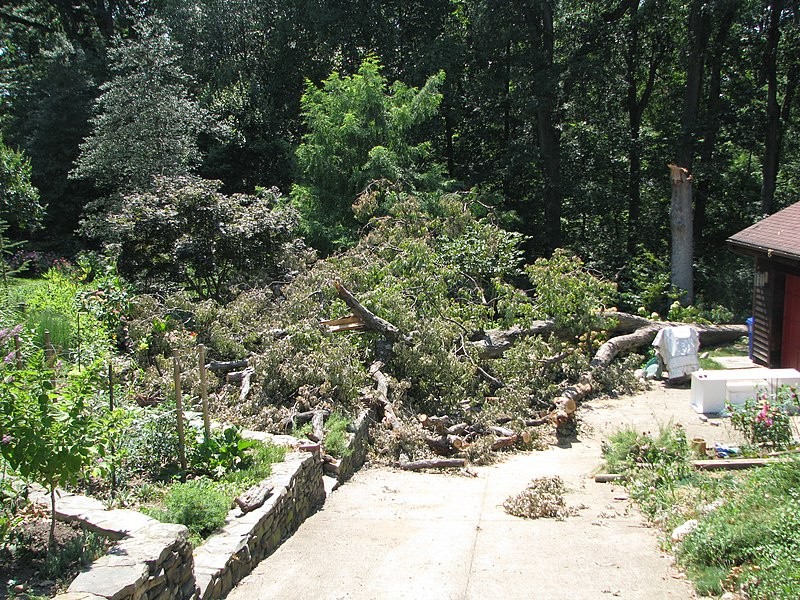It's been ten years since a devastating derecho ripped through the Washington, DC region. The 29th of June, 2012, will be difficult for people in and around Washington, D.C. to forget. A powerful line of highly gusty thunderstorms gave millions of people a new word that day: derecho.
10 Years Ago

The 2012 derecho was undoubtedly one of the worst storms in D.C. history, but the storm had an impact beyond the district's borders. It was implicated in scores of deaths throughout many states. The storm formed in derecho-prone Iowa, and it caused significant wind damage along an 800-mile course from Iowa to the Delmarva Peninsula.
Derecho Storms
The storms that became the derecho began as a largely minor complex in Iowa and northern Illinois, causing sporadic damage in Chicago's southern suburbs around noon Central Time. The first of numerous severe thunderstorm watches were issued shortly after.
As the storm progressed across Indiana, it developed the unique bow echo pattern - a curved shape that emerges on the radar in the strongest storms, including derechos. A derecho is more than just a powerful windstorm; the National Weather Service's Storm Prediction Center (SPC) uses specific criteria to determine whether a storm complex qualifies as a derecho.
"A derecho wind damage swath must stretch either continuously or intermittently more than 400 miles with a breadth of at least 60 miles," the SPC explained on its website, outlining the newly modified criteria used to determine a storm is a derecho. In previous years, a storm complex was considered a derecho if it produced wind gusts of 58 mph or more along a significant section of its route and straight-line wind damage reports along a 240-mile path or greater.
As the 2012 derecho swept over the Ohio Valley, it became evident that the storm would likely retain derecho strength as it passed through inhabited areas. The largest wind gust in the storm's history was recorded in Fort Wayne, Indiana, at 91 mph.
The storm moved into Indiana, Ohio, northern Kentucky, and West Virginia, wreaking havoc and prompting the SPC to issue a severe thunderstorm watch for parts of Virginia, Maryland, and the entire nation's capital.
In Washington, D.C., conditions were favorable for the derecho to sustain its severity even as the storm came into the area during the evening hours when the atmosphere was less conducive to violent thunderstorms. Temperatures had just reached a record high of 104 degrees, releasing a lot of energy into the sky and fueling a fierce round of storms.
Bracing Up

Meteorologists were prepared for the powerful windstorm as the sun fell in and around the nation's capital. A severe thunderstorm watch was issued at 6:30 p.m., hours before the storm's arrival around 11 p.m. Nonetheless, the ferocity of the winds, which gusted at more than 80 mph, stunned many in the region, as storms were not predicted by most until only hours before they ripped across the region.
The storm had already passed over western D.C. by 11 p.m., stranding hundreds of thousands of people.
"It was amazing looking to the northwest and watching blue sparks light up the sky as transformer after transformer broke as the line was pressing through," AccuWeather's Tim Felice, a longtime resident of Arlington, Virginia, said.
Extreme Weather Event
AccuWeather Digital Journalist John Murphy was in Leesburg, Virginia, at the time, and he recalls what he believed was a historical derecho as it blew into the town.
"I will never forget the deafening howl of the wind when the derecho first reached my house in Leesburg," Murphy remarked.
As limbs and trees fell over the neighborhood, terrifying wind gusts startled many individuals. The lightning was very powerful, making the normally dark sky appear more like a strobe light. The sounds of thunder and lightning were replaced by sirens but an otherwise eerie calm, with power disruptions grinding the region to a standstill in the aftermath of the late-night walloping.
"When [the winds struck], the trees started moving in ways I'd never seen them move before, bending like flexible dancers, and my eyes were becoming coated in dust," said George Matovu, an atmospheric science major at George Mason University. The latter resided in Herndon, Virginia, during the storm. "The electricity went out around 90 seconds to two minutes into the approximately 50- to 60-mile-per-hour wind gusts, and I walked inside."
More than a million people in and around Washington, D.C., were without power due to the storm and even disrupted 911 services in certain areas of the region. According to WJLA, more than 300 damage complaints were filed in and around the nation's capital.
Overall Casualties
Overall, the derecho killed scores of people, some directly from falling trees and others from the high heat that followed the storm, and the overall damage from the long-tracked storms neared $3 billion. More than 4.2 million people in the derecho's route lost electricity, laying the groundwork for a second disaster: a huge heat wave with millions without air conditioning.
There hasn't been an extensive and powerful storm in the Washington, D.C., region since the 2012 derecho. However, several other.
Related Article : Exposure to Major Disasters Can Cause Long-Term Mental Health Problems
For more climate and weather updates, don't forget to follow Nature World News!
© 2025 NatureWorldNews.com All rights reserved. Do not reproduce without permission.





